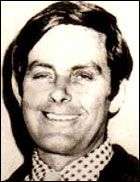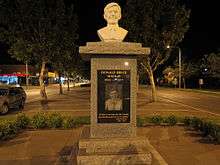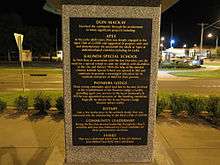Donald Mackay (anti-drugs campaigner)
| Donald Mackay | |
|---|---|
 | |
| Born |
Donald Bruce Mackay 13 September 1933 Griffith, New South Wales |
| Died | 15 July 1977 (aged 43) |
| Occupation | Businessman |
| Known for | Anti-drugs campaigning |
| Spouse(s) |
Barbara Mackay (m. 1957–1977) |
| Children | James, Paul, Ruth and Mary[1] |
Donald Bruce Mackay (13 September 1933 – 15 July 1977) was an Australian businessman. He was also a prominent substance abuse campaigner who came to media attention and fame in 1977 through the circumstances of his murder, which has never been solved.
Personal life and background
Mackay was born in Griffith and raised in Sydney. He and his family ran a furniture business in Griffith called Mackay's Furniture.[2]
His wife Barbara (1935–2001) was an active member of the Uniting Church in Griffith and was a part-time physiotherapist. Today, the Mackay family still has a property in Griffith,[3] and Donald Mackay's son, Paul, now runs the family furniture store.[4]
In 1974, Mackay stood as a Liberal Party candidate for the House of Representatives against Al Grassby in the electorate of Riverina. His preferences went to the Country Party candidate John Sullivan, allowing Sullivan to unseat Grassby.[5] McKay also stood for the Liberal Party in the state seat of Murrumbidgee at the 1973 and 1976 New South Wales state elections, but was unsuccessful.
Lead-up to murder
Concerned about the growing drug trade in his local area, and learning of a large crop of marijuana in nearby Coleambally, Mackay informed Sydney drug squad detectives, resulting in several arrests and the conviction of four men of Italian descent. At the trial of the arrested men, Mackay was identified as the whistleblower.[6]
An attempt was made to lure Mackay to Jerilderie by a "Mr Adams" who wished to make a large order of furniture from Mackay's family business. Mackay, busy with other matters, sent employee Bruce Pursehouse to meet "Adams", who did not approach Pursehouse. This is believed to have been an attempt to assassinate Mackay. Pursehouse later identified a man he had seen at Jerilderie as a suspect in the Mackay killing.[7]
Evening of Mackay's murder
On 15 July 1977, Mackay disappeared from a hotel car park after having drinks with friends and has never been found. Stains from his blood group were evident on his van[8] and the ground nearby, and his car keys were underneath the van.[9] Nearby were drag marks, hair, and three spent .22 calibre cases.[10]
The Woodward Royal Commission found that the six prime suspects to the murder all had convenient alibis.[11] On the night of the murder, Tony and Domenic Sergi, nominated as principal suspects by the Commission, were on a "pub crawl" in Griffith with a number of police officers;[11] Giuseppe and Rocco Barbaro went to Sydney and, then, the Gold Coast, not returning to Griffith until 20 July;[11] Francesco Barbaro, brother-in-law of Tony Sergi and cousin of Saverio Barbaro (who had been arrested three months earlier for marijuana production), stayed at the Griffith Ex-Servicemen's Club;[11] and Robert Trimbole was at Randwick, Sydney, at a restaurant.[11]
Mackay's disappearance made headlines around the nation and many, such as Griffith supervisor of detectives James Bindon, drew the conclusion that gangland figure Robert Trimbole was responsible for the apparent contract-style killing.[12] Trimbole had previously made death threats against Mackay.[12] The killing fuelled the perception of Griffith as full of mobsters and "Australia's marijuana capital".[13]
Woodward Royal Commission
The Mackay case led to the then-premier Neville Wran appointing Justice Philip Woodward to lead the Woodward Royal Commission into the illegal drug trade in New South Wales. In 1979, Woodward found that Mackay had been murdered by a hitman acting on instructions from the "Honoured Society", a Griffith-based cell of the 'Ndrangheta, a Calabrian criminal organisation.[14][15]
Justice Woodward, in his final report, concluded that the members of this organisation involved in Mackay's murder were Francesco Sergi (born 24 January 1935), Domenic Sergi (born 3 March 1939), Antonio Sergi (born 4 February 1950), Antonio Sergi (born 29 October 1935), Francesco Barbaro (born 8 September 1937) and Robert Trimbole (born 19 March 1931).[16] Justice Woodward requested for police to search Griffith's "grass castles" but this was denied.[17]
Aftermath of Mackay's murder
In 1980, Al Grassby was charged with criminal defamation when it was alleged that he had asked New South Wales state politician Michael Maher to read in the New South Wales Legislative Assembly a document that imputed Mackay's wife Barbara and her family solicitor were responsible for Mackay's disappearance. An inquiry by John Nagle Q.C. found that "no decent man" could have spread the "scurrilous lies" that Grassby had.[18] Grassby maintained his innocence and fought a 12-year battle in the courts before he was eventually acquitted on appeal in August 1992 and was awarded A$180,000 in costs.[19] Grassby had already lost a civil suit filed by Barbara Mackay, forcing him to unconditionally apologise.[20]
In 1984, the coroner ruled Mackay had died of "wilfully inflicted gunshot wounds".[21]
In 1986 hitman James Frederick Bazley was charged over the death.[22] Bazley claimed he was innocent, blaming allegedly corrupt former Sydney detective Fred Krahe as the killer,[23] but was convicted of conspiring with Gianfranco Tizzone, Robert Trimbole, George Joseph and unknown other persons to murder Mackay, as well as the murders of drug couriers Douglas and Isabel Wilson.[10] He was sentenced to life imprisonment.[21]
Gianfranco Tizzoni, who turned informer in 1983, admitted to his 'complicity' in Mackay's murder.[24] Specifically, Tizzoni admitted that he arranged for a hitman he knew as 'Fred' to undertake the contract.[25] When shown photographs of possible suspects, Tizzone fingered Bazley as the trigger man.[25]


In July 2012, 35 years after his disappearance, the New South Wales police offered a $200,000 reward for information on the whereabouts of Mackay. The reward was considered a last-ditch attempt to gain evidence from reluctant witnesses. In particular those of Bazley, who is 86 and unwell. However, in the rare moments he has broken his silence, Bazley denied he was the killer.[26]
Legacy
The annual Donald Mackay Churchill Fellowship was inaugurated in 1987.[27] The Churchill Trust awards a Donald Mackay fellowship annually for journalists and detectives to study methods of investigating and bringing to light organised crime.[28]
In late 2008, the Rotary Club of Griffith erected a memorial in Banna Avenue, the main street of Griffith, to honour the 30th anniversary of Donald Mackay's murder.[18][29] The statue of Donald Mackay itself is a white marble bust with a plaque inscribed with "All that is necessary for the triumph of evil is for good men to do nothing. "
Media
Australian actor Andrew McFarlane portrayed him in the 2009 television series Underbelly: A Tale of Two Cities.[30]
References
- ↑ "Legislative Assembly for the ACT: 2007 Week 3 Hansard (14 March). . Page.. 574." Legislative Assembly for the ACT. 14 March 2007. Retrieved 19 May 2011.
- ↑ Silvester, John; Rule, Andrew (9 May 2010). "Biographies". Underbelly: A Tale of Two Cities. Floradale Productions & Sly Ink. ISBN 978-0977544097.
- ↑ Hicks, Lesley (14 July 2017). "Forty years after Donald Mackay's murder, the Calabrian mafia still thrives". The Sydney Morning Herald. Retrieved 13 July 2018.
- ↑ Wood, Richard (14 July 2017). "Still no body found after infamous political assassination 40 years ago". Nine News. Retrieved 13 July 2018.
- ↑ Poprzeczny, Joseph (4 April 2009). "BOOKS: SMACK EXPRESS: How Organised Crime Got Hooked on Drugs, by Clive Small and Tom Gilling". News Weekly. Archived from the original on 14 October 2009. Retrieved 19 May 2011.
- ↑ Wright, Tony (30 April 2011). "Heartache has no end for family of Donald Mackay". The Age. Retrieved 19 May 2011.
- ↑ Jenny Cooke (4 July 1986). "Witness still sees the face of a killer". Sydney Morning Herald.
- ↑ "Mackay inquest December 6". Sydney Morning Herald. 28 July 1982.
Blood of the same group as Mr Mackay's was found spattered over the off-side bonnet and front tyre of his abandoned Minivan.
- ↑ "Mackay killed for $10,000, inquest told". Sydney Morning Herald. 14 March 1984. p. 1.
Underneath were his car keys and nearby there were bloodstains...
- 1 2 Jenny Cooke (17 April 1986). "Twisting trail that led to Mackay's murderer". Sydney Morning Herald.
While Mr Mackay's body has never been found, drag marks, hair and three spent .22 cartridge cases were found near his minivan in the hotel carpark the next day.
- 1 2 3 4 5 Bottom, Shadow of Shame, p. 29
- 1 2 "Inquiry told of Trimbole's 1974 threat to kill Mackay". The Sydney Morning Herald. 16 June 1986.
- ↑ Tony Harrington (16 June 1983). "Aussie Bob, the panel beater who became a millionaire". The Age. p. 10.
- ↑ David Elias (8 November 1979). "Secret crime report; State warned 15 years ago on Calabrians". The Age. p. 1.
Mr. Justice Woodward linked the Honored Society with the control of drugs around Griffith, the murder of anti-drug campaigner Mr. Donald Mackay and the 1963 Victoria Market murders.
- ↑ "Mackay killed by Griffith drug group, judge finds". The Sydney Morning Herald. 7 November 1979. p. 1.
Mr Donald Bruce Mackay was murdered and disposed of by a Griffith-based organisation, Mr Justice Woodward found in his report.
- ↑ Bottom, Shadow of Shame, p. 46
- ↑ Bottom, Shadow of Shame, p. ?
- 1 2 Sheehan, Paul (16 February 2009). "Monuments to honesty and deceit". The Sydney Morning Herald. Retrieved 19 May 2011.
- ↑ Heinrichs, Paul (24 April 2004). "Al Grassby, father of multiculturalism, dies". The Age. Retrieved 19 May 2011.
- ↑ Jenny Cooke (1 June 1988). "Prosection appeals over Grassby decisions". Sydney Morning Herald. p. 11.
Mr Williams – partly due to the lengthy delay in bringing the charge and the fact that Mrs Mackay already had won a civil suit with an unconditional apology from Mr Grassby – permanently stayed the criminal defamation.
- 1 2 Gregory, C. A. (2000). "Mackay, Donald Bruce (1933–1977)". Australian Dictionary of Biography. Canberra: Australian National University. Retrieved 19 May 2011.
- ↑ Brown, Malcolm (16 February 2009). "Dramatic Underbelly upsets those who were there". WAtoday.com.au. Retrieved 19 May 2011.
- ↑ Bellamy, Patrick. "The Fixer: The Rise and Fall of Australian Drug Lord Robert Trimbole". truTV. Retrieved 19 May 2011.
- ↑ Bottom, Shadow of Shame, p. 80
- 1 2 Bottom, Shadow of Shame, pp. 85–86
- ↑ Police hope $200,000 may prise open the secret of Donald Mackay's grave, The Age, 14 July 2012
- ↑ "Donald Mackay". Winston Churchill Memorial Trust. Retrieved 19 May 2011.
- ↑ "Trust will continue Donald Mackay's crime fight". Sydney Morning Herald. 3 February 1987.
- ↑ "Mackay's son pushes for bigger crime crackdown". ABC News. Australian Broadcasting Corporation. 13 October 2008. Retrieved 19 May 2011.
- ↑ Blundell, Graeme (7 February 2009). "Crime time". The Australian. Retrieved 19 May 2011.
- Notes
- Bottom, Bob (1988). Shadow of Shame: How the mafia got away with the murder of Donald Mackay, Victoria (Australia): Sun Books, ISBN 0-7251-0558-5
External links
- The Hit, Courtroom TV Crime Library.
- The Assassination of Mr Donald Mackay, Legislative Council Hansard (Extract).
- Mafia killers escape justice as new Mackay inquiry rejected, Adelaide Now.
- Donald Mackay at Find a Grave